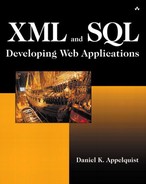Summary
XML design is a creative process and requires intuitive thinking. In this chapter, I've shown you an approach to XML design that I've used with some success. The value of XML is that you don't need to be a professional information designer to start using it in projects. And once you start using it, you begin thinking of new uses for it, new places where it can fit to enhance reliability and interoperability.
If there's an XML DTD that already does what you need it to do, use it; it will save you some of the trouble and headache of building your own DTD. If you're lucky, you may find a DTD that is close to your needs. This DTD may even have been designed by a consortium or industry group that you can join, which enables you to participate in its further development. Joining industry groups like these can pay off in other ways, as well; you are exposed to the ideas and thinking of other industry professionals.
If you're looking for a more comprehensive reference to XML design and application, you can't go wrong with Just XML by John E. Simpson (2000). For the full DTD for our CyberCinema example, see the Appendix.
So, where does the SQL bit come in? In the next chapter, we'll discuss SQL schema design and integration of the schema with XML.
